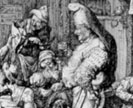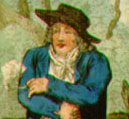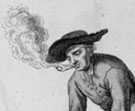> DRY
DRUNK
THE CULTURE OF SMOKE: LOW-LIFE
The peasant is by far the single class of character most commonly represented
smoking. The origins of the low-life smoker can be found in Dutch 17th-century
art, where s/he is embodied in countless examples by specialists of the genre
such as Adriaen van Ostade, Cornelis Dusart, and David Teniers. The genre's
long-lived and widespread popularity is evident in innumerable copies and
adaptations, including the likes of Madame Pelletier's engraving after van
Ostade's old smoker and Gainsborough's Gipsies. Tobacco, with its mind-dulling
narcotic capacities, was ideally suited to such representations of the peasant,
in which his/her character ranges from naive, earthy simpleton to diligent
worker to aggressive brute. Not unlike the breakfast beer soup that predated
coffee as a morning drink, tobacco was, in a sense, a way of keeping the
lower classes in their place –a class in a perpetual state of drunkenness
poses little threat. Along the same lines, the peasant represented a means
to criticize tobacco use as a dirty and unsophisticated custom, but at the
same time to justify further commerce in tobacco and its related products.
Although they are far from straightforward "snapshots" of Dutch life, these
images do provide us with details of daily life in 17th-century Holland,
informing the viewer about the accoutrements of the everyday, including of
course the paraphernalia of smoking, from the paper full of dried tobacco
leaves and the knife used to cut and prepare the herb for consumption to
the pot of coals in which the pipe was awkwardly lit.
66
Pieter Nolpe (Dutch, ca. 1613–ca. 1653)
after Pieter Quast (Dutch, 1606–1647)
Group of peasants smoking and drinking
Engraving, 1638
Print Collection, David McN. Stauffer Collection
 Artists depicting Dutch peasants seem to have reveled in the basics
of human existence: during the 17th century, tobacco smoking joined eating,
drinking, and relieving oneself. The fellow at right holds a tall "measure
glass," and is informing his companions that he has just drunk precisely
one measure of beer. Before the introduction of coffee, tea, and chocolate,
beer was the drink of the people, consumed at all times, for sustenance
as well as for pleasure, although most representations feature the latter.
Artists depicting Dutch peasants seem to have reveled in the basics
of human existence: during the 17th century, tobacco smoking joined eating,
drinking, and relieving oneself. The fellow at right holds a tall "measure
glass," and is informing his companions that he has just drunk precisely
one measure of beer. Before the introduction of coffee, tea, and chocolate,
beer was the drink of the people, consumed at all times, for sustenance
as well as for pleasure, although most representations feature the latter.
67
Cornelis Dusart (Dutch, 1660–1704)
The Fiddler in the Inn
Etching, 1685
Print Collection
 Dusart was one of Holland's most dedicated painters of raucous tavern
scenes. The Latin inscription indicates that the work was intended for
an educated audience, and alludes to the honesty and simplicity of rustic
life, which lacks hypocrisy. Clay pipes, the making of which was a Dutch
specialty, are seen in various guises throughout Dusart's composition:
a young boy warms a pair of them over the fire, while a hunched-over old
smoker on the bench enjoys his quietly; in the background, a man lights
his in a pot of coals. The standing figure in the middleground, right,
is just about to take a pinch of snuff.
Dusart was one of Holland's most dedicated painters of raucous tavern
scenes. The Latin inscription indicates that the work was intended for
an educated audience, and alludes to the honesty and simplicity of rustic
life, which lacks hypocrisy. Clay pipes, the making of which was a Dutch
specialty, are seen in various guises throughout Dusart's composition:
a young boy warms a pair of them over the fire, while a hunched-over old
smoker on the bench enjoys his quietly; in the background, a man lights
his in a pot of coals. The standing figure in the middleground, right,
is just about to take a pinch of snuff.
68
Jonas Suyderhof (Dutch, ca. 1613–1686)
after Adriaen van Ostade (Dutch, 1610–1685)
Three peasants in an interior
Etching and engraving, n.d.
Print Collection

69
Gillis van Scheyndel (Dutch, ca. 1595/1600–1649)
Peasants carousing under a lean-to
Etching, 1620s
Print Collection, David McN. Stauffer Collection
70
Unidentified
after David Teniers the Younger (Flemish, 1610–1690)
Party drinking and smoking outdoors
Etching, n.d.
Print Collection
 Groups of smoking, drinking peasants were one of the specialties of
the exceedingly prolific younger Teniers, and hundreds if not thousands
of prints were made after his drawings and paintings. This outdoor scene
takes place in front of an inn, identified by the beer mug hanging above
the door.
Groups of smoking, drinking peasants were one of the specialties of
the exceedingly prolific younger Teniers, and hundreds if not thousands
of prints were made after his drawings and paintings. This outdoor scene
takes place in front of an inn, identified by the beer mug hanging above
the door.
71
Jacob Gole (Dutch, ca. 1660–1737)
after David Teniers the Younger (Flemish, 1610–1690)
The Three Smokers
Mezzotint, n.d.
Arents Tobacco Collection
Although smokers often seem to be lighting their pipes directly on the
hot coals inside the pot, Teniers frequently shows the seemingly more practical
use of matchsticks that are first lit upon the coals.
72
Mme. Pelletier (French, 2nd half 18th century)
after Adriaen van Ostade (Dutch, 1610–1685)
Le Fumeur [The smoker]
Etching with engraving, n.d.
Print Collection, Samuel P. Avery Collection
Madame Pelletier and her husband, Jean, were both professional engravers
who made prints after the works of famous painters, including contemporary
as well as occasional 17th-century Dutch genre pieces such as this one
after the Haarlem peasant painter Ostade. This print is included in an
unusual collection of prints and drawings by women artists that was assembled
by a Dutch print curator's wife in the mid-19th century.
73
Thomas Gainsborough (British, 1727–1788)
and John Wood (British, 1720–ca. 1780)
The Gipsies
Etching, 1764 (original etching ca. 1653/54)
Print Collection, Gift of Harold Halperin
 The successful portrait painter Gainsborough made only two line etchings,
both of them worked up and finished by the etcher and engraver John Wood.
Later in his career, Gainsborough picked up printmaking once again, using
newer techniques that were able to approximate the quality of chalk and
wash drawings.
The successful portrait painter Gainsborough made only two line etchings,
both of them worked up and finished by the etcher and engraver John Wood.
Later in his career, Gainsborough picked up printmaking once again, using
newer techniques that were able to approximate the quality of chalk and
wash drawings.
74
Jack Sharp (British, mid-18th century)
Margaret Finch, Queen of the Norwood Gypsies, Died 1740, Aged 108 Years
Engraving from: The Wonderful Magazine and Marvelous Chronicle, no.
3. London: C. Johnson, April 1, 1793
Arents Tobacco Collection
This would be a good advertisement for tobacco and longevity, but for
the fact that the 108-year-old Margaret Finch, it was said, could not be
taken out of the posture in which she is here represented. As reported
in the magazine:
By her constant custom of sitting on the ground with her chin
resting on her knees, . . . her sinews became so contracted, that she could
not extend herself, or change her position, so that when she died her corps
was forced to be crammed into a box sizeable to her usual posture, and
therein conveyed in a hearse accompanied by two coaches to Becknam in Kent,
where she was decently interred. . . .
75
Cornelis Dusart (Dutch, 1660–1704)
L'Archevêque de Rheims, L'Asne Mitré [The Archbishop of
Rheims, the mitred jack-ass]
Mezzotint in: Les Héros de la Ligue [Heroes of the league]. Paris:
Père Peters, 1691
Print Collection, Gift of Mrs. Henry Draper
Even the clergy were not immune to vulgar criticism, including that
of their tobacco use. The shells on the Archbishop's cap are appropriate
to the Christian pilgrim, but the dice, the cards, the little liquor bottles
(?), and the rows of clay pipes tucked into the top layer are not. This
rotund Archbishop is ambitious: the text below hints that he aspires to
the position of Patriarch of Jerusalem.
76
George M. Woodward (British, 1760–1809)
Itinerant Dealers in Staffordshire Ware
Hand-colored etching in his: Eccentric Excursions or Literary & Pictorial
Sketches of Countenance, Character & Country in Different Parts of England & South
Wales. London, 1796
Print Collection
 "Sketched from nature," these dealers in Staffordshire ceramics rest
along the road, like Gainsborough's gypsies, in a surprisingly benign family
image of a transient class.
"Sketched from nature," these dealers in Staffordshire ceramics rest
along the road, like Gainsborough's gypsies, in a surprisingly benign family
image of a transient class.
77
Jacques Lagniet? (French, 1620–1672)
Tel fait la faute qu'un autre boit [One makes the mistake, another
drinks it]
Etching bound in a collection of proverb etchings published by Lagniet, ca.
1660
Print Collection, Kennedy Fund
 More than just an illustration of a single proverb, this image of rough-and-ready
taverngoers seems to radiate desperation, most eloquently expressed in
the title proverb: the fellow beneath the table laps up the beer from the
pot accidentally kicked over by the smoker (who, according to the text,
lives on tobacco). His tobacco, in a large piece of paper on the table,
is labelled "meat of drunkards," and an inscription near the clouds of
tobacco smoke says that "all their goods disappear in a puff of smoke."
More than just an illustration of a single proverb, this image of rough-and-ready
taverngoers seems to radiate desperation, most eloquently expressed in
the title proverb: the fellow beneath the table laps up the beer from the
pot accidentally kicked over by the smoker (who, according to the text,
lives on tobacco). His tobacco, in a large piece of paper on the table,
is labelled "meat of drunkards," and an inscription near the clouds of
tobacco smoke says that "all their goods disappear in a puff of smoke."
78
Adriaen Matham (Dutch, ca. 1600–1660)
after Adriaen van de Venne (Dutch, 1589–1662)
Attempt to put out the fire of the smoking peat-bargeman
Engraving in: Adriaen van de Venne. Sinnevonck op den Hollandschen Turf
[Sparkling thoughts on Dutch peat]. The Hague: Isaac Burchoorn, 1634
Arents Tobacco Collection
In a recreation of a Sir Walter Raleigh smoking myth, a pipe-smoking
peat bargeman is thought to have caught on fire: frightened onlookers try
hastily to put out the flames. In the original version, Raleigh finds himself
soaked in beer after a surprised spectator sees smoke emanating from his
head.
79
Pierce Tempest (British, d. 1717)
after Marcellus Laroon (British, 1653–1705)
Knives or Cisers to Grind
Etching in his: The Cryes of the City of London: Drawne After the Life
in 74 Copper Plates. London: P. Tempest, 1711
Print Collection
 Series of cries of Rome, Paris, and London enjoyed a development parallel
to that of costume plates, with the characters portrayed localized to one
place and socio-economic level, mostly itinerant street salesmen. These
included figures selling everything from cherries to coffee and brooms,
as well as figures such as this knife grinder, puffing away diligently
on his pipe, which seems to aid his concentration.
Series of cries of Rome, Paris, and London enjoyed a development parallel
to that of costume plates, with the characters portrayed localized to one
place and socio-economic level, mostly itinerant street salesmen. These
included figures selling everything from cherries to coffee and brooms,
as well as figures such as this knife grinder, puffing away diligently
on his pipe, which seems to aid his concentration.







